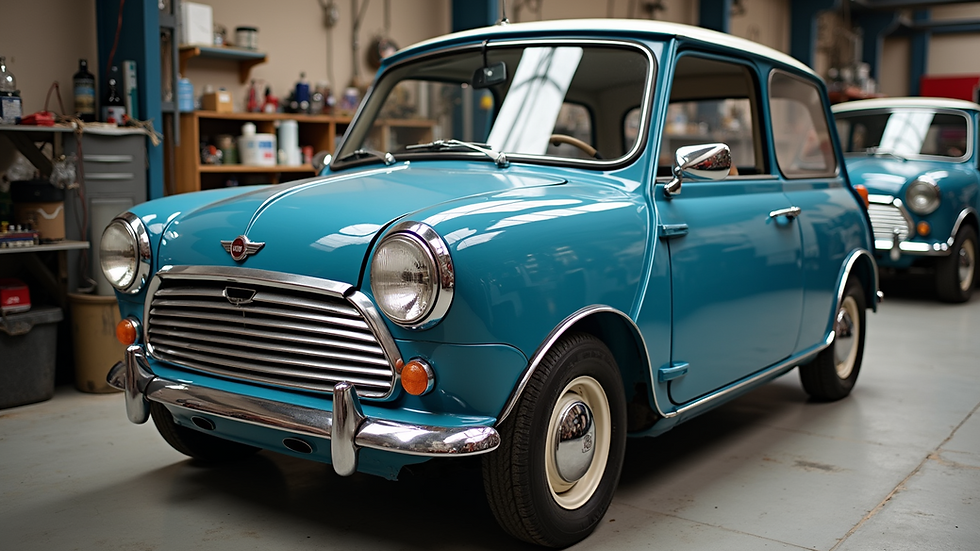Exploring 3D Printed Parts for the Classic Austin Mini Blue Shark Restoration
- blueshark3d
- Sep 30
- 3 min read
The Austin Mini is more than just a car. Since its launch in 1959, it has become a symbol of creative engineering and compact design. Known for its front-wheel-drive layout and agile handling, the Mini quickly gained popularity worldwide. Today, classic car restoration is thriving, and modern technology, particularly 3D printing, is transforming how these iconic vehicles are brought back to life. In this post, we will dive into the importance of 3D printed parts in restoring the Austin Mini, focusing on the distinctive Blue Shark variant.
The Legacy of the Austin Mini
Designed by Sir Alec Issigonis, the Austin Mini was produced by the British Motor Corporation (BMC) until 2000. Its compact size and efficient use of space made it a favorite among many drivers. For nearly 50 years, the Mini's design philosophy balanced functionality with style, keeping it relevant among classic car enthusiasts.
The Blue Shark variant is especially valued for its unique color and sporty features, making it a prized possession among collectors. Restoring a Blue Shark Mini involves not just mechanical repairs but also meticulous attention to detail. This is where 3D printed parts can greatly enhance the restoration process.
The Role of 3D Printing in Restoration
3D printing technology has changed the way classic cars are restored. It allows for the creation of custom parts that are no longer available in the market. For the Austin Mini, this means that enthusiasts can replicate hard-to-find components to ensure authentic restorations.
Customization and Precision
One major benefit of 3D printing is the ability to customize parts to meet specific needs. For example, if a component of the Blue Shark is damaged or missing, a 3D model can be created based on the original specifications. This precise fit is vital for maintaining the integrity of the vehicle and ensures optimal performance.
Additionally, 3D printing opens the door to various materials, including plastics and metals. This flexibility allows restorers to choose the best material for their specific needs. For instance, if original metal trims are no longer available, using durable plastic for a replica can still maintain the car’s appearance and functionality.

Cost-Effectiveness
Restoring a classic car can be costly, especially when sourcing original parts. 3D printing offers a more affordable alternative. It eliminates the need for expensive molds and tooling, allowing parts to be produced on-demand. This approach not only reduces waste but also cuts down overall restoration costs, which can save car enthusiasts up to 50% on certain parts.
This cost-effectiveness is particularly attractive for those restoring the Austin Mini Blue Shark. For example, instead of spending $500 for a rare dashboard piece, a 3D printed version could be created for around $100, allowing for more extensive modifications without the financial strain.
Practical Applications of 3D Printed Parts
3D printed parts have a wide range of applications in the restoration of the Austin Mini. Here are a couple of practical examples:
Interior Components
The Mini's interior is known for its distinctive design. Using 3D printing, restorer can create custom dashboard components, knobs, and trim pieces. For instance, if the original speedometer bezel is cracked, a new one can be made with precise dimensions and a matching design.
Exterior Trim and Badges
Maintaining the original look of the Blue Shark variant is crucial. 3D printing can replicate lost or damaged exterior trim pieces and badges. This attention to detail can significantly enhance the car’s overall aesthetic. For example, a replacement for a missing badge can take just a few hours to print but improves the car's authenticity dramatically.

Challenges and Considerations
While 3D printing has many advantages, it also presents certain challenges. The quality of printed parts can differ based on the printer and materials used. It’s vital for restorers to collaborate with reputable 3D printing services or invest in high-quality printers to ensure that parts meet the required standards.
Moreover, understanding the legal aspects of reproducing certain parts is essential. Some components may fall under intellectual property laws. To avoid potential issues, research and ensure compliance before initiating production.
Reviving a Classic with Modern Technology
Restoring the Austin Mini Blue Shark combines timeless nostalgia with cutting-edge technology. Incorporating 3D printed parts into the restoration process enhances both the precision and quality of the work while maintaining the vehicle's authenticity. As technological advancements continue, the possibilities for classic car restoration will keep expanding, creating exciting opportunities for enthusiasts.
Whether you are a seasoned restorer or just starting your journey into classic cars, 3D printing technology offers new avenues for your projects. The Austin Mini Blue Shark is a testament to innovative design and engineering. With modern tools, its legacy can be preserved and celebrated for many generations to come.





Comments